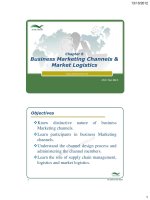Business Environment 8_market structures, market forces, competition commission
Bạn đang xem bản rút gọn của tài liệu. Xem và tải ngay bản đầy đủ của tài liệu tại đây (253.17 KB, 31 trang )
LECTURE for BE ASSIGNMENT 2
TASK 3
1
TASK 3A
Sources:
1.BE_Market Structures Video:
C:\BTEC\BE\economics videos\BE_Market Struc
tures.flv
2.BPP Business Environment Coursebook
(pages 238 -245)
Market Structures
The term market structure is used to describe:
The number of buyers and sellers operating in a market
The extent to which the market is concerned in the hands of
a small number of buyers and/ or sellers.
The degree of collusion or competition between buyers and/
or sellers
Source: BPP Professional Education, 2004, p. 258)
3
Market Structures
Four main types of market
1.
2.
3.
4.
4
Perfect competition
Monopoly
Oligopoly
Monopolistic competition
Perfect Competition
Exists when there are so many people in the market, and other conditions are
such, that no-one can influence the price, all other things being equal.
Characteristics:
There are many buyers and sellers. None of them could have influence on the
market price. Buyers and sellers must accept the price which the market
determine. Therefore, they are pricetakers.
Homogenous products.
Free entry and exit the market.
Information is always available for buyers and sellers.
Revenues of a competitive firm:
Average revenue: total revenue divided by the quantity sold
Therefore, for all firms, average revenue equals the price of the good.
Marginal revenue: the change in total revenue from an additional unit sold.
Therefore, for competitive firms, marginal revenue equals the price of the good.
Source: BPP Professional Education, 2004, p. 239
5
Perfect
Competition
FIGURE shows the:
-The goal of firms is profit maximization:
Marginal-cost curve (MC)
Average-total-cost curve (ATC)
Average variable-cost curve (AVC)M
Market price (P) = Marginal revenue
(MR)
= average revenue (AR);
P=MR=AR
At the quantity Q1, marginal
revenue MR1 exceeds marginal cost
MC1, so raising production increases
profit.
At the quantity Q2, marginal cost
MC2 is above marginal revenue
MR2, so reducing production
increases profit.
The profit-maximizing quantity
QMAX is found where the horizontal
price line intersects the marginal6 cost curve.
Monopoly
Exists when there is only one supplier of a product or
services. (BPP Professional Education, 2004, p.241)
Characteristics:
There is only one firm in the market
A price is made by a firm.
Customer choice limited.
Joining into market is very difficult because
there are many barriers to entry such as a main
resources are owned by a firm, the government
gives a firm which is monopoly for a particular
products or services like electric, water, etc.
7
Oligopoly
Few large suppliers, whose business decisions affect
each other. (BPP Professional Education, 2004, p. 242)
Characteristics:
There are a few large firms in the market.
Products could be same or different but they
are concerned into some firms.
Highly barrier to entry.
Have an interdependence between companies
in the market.
8
Monopolistic competition
Occurs when a large number of firms sell closely related,
but not homogenous products. Instead, the products are
said to be “differentiated” and
not seen as prefect
substitutes by consumers. There is a heavy reliance on
non-price actions eg, advertising, to differentiate the
product. (BPP Professional Education, 2004, p. 244)
Characteristics:
A large of sellers and buyers
Easy to entry and exit the market
Product differentiated so each company have a
tiny market.
The firms which join the market later are
pricetakers. They have no affect on the market
price.
9
Relate to Giay Viet
(See Assignment 2 Guideline)
Monopolistic competition
In a monopolistically competitive
market, if firms are making profit,
new firms enter, and the demand
curves for the current firms shift
to the left.
Similarly,
if firms are making
losses, old firms exit, and the
demand curves of the remaining
firms shift to the right.
Because of these shifts in demand,
a monopolistically competitive firm
eventually finds itself in the longrun equilibrium shown here. I
In this long-run equilibrium, price
equals average total cost, and the
firm earns zero profit.
10
Differences between monopolistic competition
and perfect competition
Three (3) main differences between two types of market:
For perfect competition, products are homogenous. While for
monopolistic, products are differentiated.
In contrast to competitive firms, monopolistic competitive firms produce
more products and they also take price higher.
For the relationship between price and marginal cost: For a competitive
firm, price = marginal cost. For a monopolistic competitive firm, price
exceeds marginal cost.
11
Task 3A
Explain how market structures in the above case
study
deviate from the model of perfect competition.
TASK 3B
Sources:
1.BE_Porter’s Five Forces.ppt (Mary’s lecture)
2. />3.BPP Business Environment Coursebook (pages 245-251)
13
Porter’s Five Forces (Market
Forces)
Barriers to entry
Rivalry
Threat of substitutes
Buyer power
Supplier power
14
Task 3B
Use a range of examples to illustrate the
relationship between market forces and
GiayViet Joint Stock Company responses
To answer this task:
Create 5 Forces’ analysis for Giay Viet
and its responses for each force.
Provide charts/graphs.
TASK 3C
Sources:
1.BPP Business Environment Coursebook (pages 252-257)
2.BPP Marketing Coursebook
16
Competitive Strategies
Market segmentation (p.252-253)
Marketing mix (p.254-256)
Generic/competitive strategies (p. 256-257)
- see next slides
17
Competitive Strategies
Three (3) types of competitive strategies
Cost leadership strategy – firms always seeks the
lowest - price for their products. Producing products
at the lowest-price not only help firms compete with
other producers but also create the highest unit
profits. (BPP Professional Education, 2004, p. 257)
Focus strategy - based on segmenting the market
18
and focusing on particular market segments. The
firms will focus on a particular type of buyer or
geographical area.
A cost-focus strategy involves selecting a segment of the
market and specializing in a product (or product) for that
segment.
A different-focus strategy involves selecting a segment of the
market and competing on the basis of product differentiation
for that segment. (BPP Professional Education, 2004, p.
257)
Competitive Strategies
Differentiation strategy - based on the assumption
that competitive advantage can be gained through
particular characteristics of a firm’s products or
brands. The customer is prepared to pay more for
this distinguish characteristic. Some types of
characteristics:
Colour differences
Size differences
Different wrapping or containers
Variants of the product for different market segment
Small change in products’ formulation to maintain their
novelty value
Different technical specifications
Through it, they will create a particular impression
for customer.
(BPP Professional Education, 2004, p. 257)
19
Competition Commission
The Competition Commission (CC) is one of the
independent public bodies which help ensure
healthy competition between companies in the
UK for the benefit of companies, customers and
the economy. It was established by the
Competition Act 1998. It replaced the
Monopolies and Mergers Commission on 1st
April 1999.
20
Role of competition
commission
The
Competition Commission conducts indepth inquiries into mergers, markets and the
regulation of the major regulated industries.
Every inquiry is undertake in response to a
reference made to it by another authority:
usually by the Office of Fair Trading (OFT) but
in certain circumstances the Secretary of State,
or by the regulators under sector-specific
legislative provisions relating to regulated
industries . The Commission has no power to
conduct inquiries on its own initiative.
21
Role of competition
commission
In most merger and market references the
Commission is responsible for making decisions
on the competition questions, implement
decisions on appropriate remedies.
Under the legislation that the Act replaces, the
Commission had to determine whether matter
were against the public interest.
22
The Office of Fair Trading
(OFT)
The primary role of the Office of Fair Trading is
to manage these consumer laws and to look
after the rights of consumers. At the same
time, the OFT advise businesses and traders on
fair and ethical practices. The OFT’s aim is to
achieve fairness for all in the marketplace.
23
Role of Office of Fair
Trading (OFT)
Ensure that consumers have as much choice as
possible across all different sectors of the
marketplace
Promote
and protect
throughout the UK
consumer
interest
Ensure that businesses are fair and competitive
24
Regulation
A company has to obey not only laws of
Vietnam but also particular laws of other
nations in which the company export products.
25









